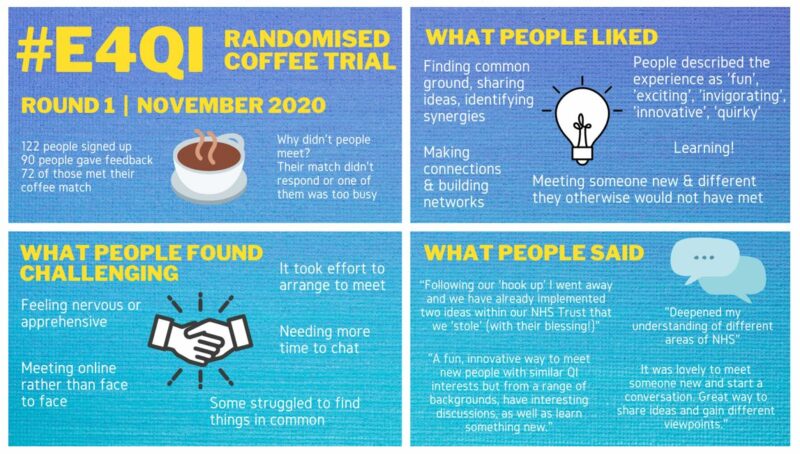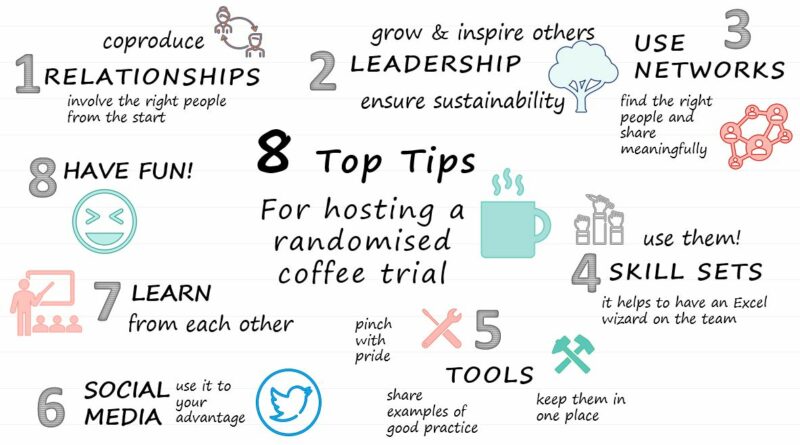Over the last year, our Evidence 4 Quality Improvement (E4QI) Q Exchange project has been working to connect improvers with the evidence needed to make decisions and bring about change. A key part of this is to connect Quality Improvement people to enable this shared learning. So, with the aim for finding ways to forge these connections, one of the project team suggested we run Randomised Coffee Trials, also known as RCTs.
RCTs randomly match members of a group or community with each other to meet informally and chat, and are run in various communities across health and care, including the Q community. To get the project started, we invited anyone who wanted to get involved to join our planning team. All were welcome whatever their (lack of) experience in planning an RCT. I for one had absolutely no experience!

Those who joined the planning team came from a range of backgrounds, geographies and experiences. We made it part of our ethos to have fun whilst working and took time to get to know each other. Building those informal relationships was as important to us as actually getting the work done. It was the gel that held the team together.
We tried to practice what we preach and ensure that we were not reinventing the wheel. We did this by truly understanding the skills and experience that we all brought to the table and sharing our materials and resources from other RCTs that we had been involved with. That meant that even before we started, we had a library of examples, templates and learning which we simply needed to tailor and make our own. This was much quicker and more efficient than starting from scratch. We shared these templates and examples with each other on our MS Teams space.
We did this by truly understanding the skills and experience that we all brought to the table
Once we had agreed the timescales for the RCT, created the emails, templates and surveys and assigned roles and responsibilities we started promoting and inviting people to sign up. We did this using a sign-up survey and an email address that we’d set up. We promoted the RCT using Twitter and though our own networks, using Piktochart to create the graphics to share on Twitter.
The team met immediately after the sign-up deadline to match people. We used a spreadsheet template, kindly shared by another team on the Academy of Fabulous Stuff. The spreadsheet required some level of excel expertise and we were incredibly fortunate to have an excel whizz on our team. Without this skillset, pairing people would have been a much more onerous and time-consuming task.
Over 120 people signed up to the RCT including several people that signed up after the deadline. That was a lesson to me. I have a tendency to be a people pleaser and wanted to pair them with each other. In fact, the counsel of the more experienced team members was quite right that we needed to stick to the original deadline as this would set a precedent (and by that stage we had already completed the matching).

Emails were sent to everyone who had signed up, introducing them to their pair. We had also tried to do something a bit different and incorporated a competition into the RCT; all pairs were invited to come up with a strapline for the next RCT in 2021. We had some fabulous entries. As a result, once all entries were in, the planning team created a shortlist and we then invited our Twitter followers to vote on their favourite.
We sent a couple of gentle prompt emails during the six week period when pairs were due to meet. A small number of people had problems contacting their pair or scheduling a time. In these cases we matched them with someone else (usually someone who had contacted us with a similar problem).
At the end of the period, we sent all participants a feedback survey. We were blown away by the high response rate; over 100 people responded out of 122 who had taken part. We met as a team to analyse the feedback and to reflect on the takeaway learning for us as a team. We were committed to sharing our learning and different members of the team have since presented our learning at different conferences and events. We also wanted to use pictures rather than words and were delighted when the talented 9 year old Finlay Treadway (the son of one of team member, Victoria) kindly offered to create some graphics to share the key points that we had taken away from our experience. I’m sure you’ll agree they are great!